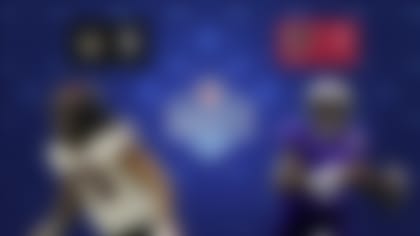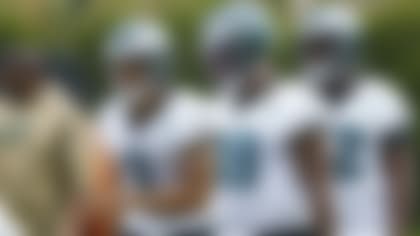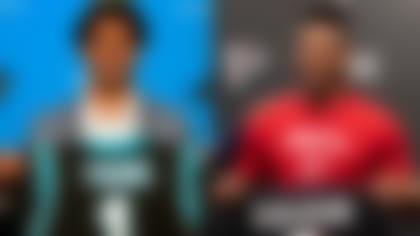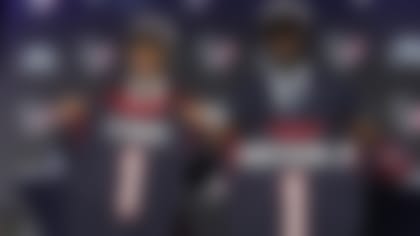Why provide instant grades on the selections of prospects who have yet to take an NFL snap? Well, you're reading this, aren't you? Considering the makeup of every roster and the factors surrounding each pick, Gennaro Filice and Dan Parr rank the 2021 draft classes, 1-32.
Round 1:
- (No. 11) Justin Fields, QB, Ohio State
Round 2:
- (39) Teven Jenkins, OT, Oklahoma State
Round 5:
- (151) Larry Borom, OL, Missouri
Round 6:
- (217) Khalil Herbert, RB, Virginia Tech
- (221) Dazz Newsome, WR, North Carolina
- (228) Thomas Graham Jr., DB, Oregon
Round 7:
- (250) Khyiris Tonga, DT, BYU
FILICE: Oh, what a difference a draft pick makes! Amirite, Matt Nagy and Ryan Pace?? Back in January, after news broke that Chicago would be retaining the embattled coach-GM duo for 2021, Bears fans got mad online. Looking to explain the decision and address fan uproar, team chairman George McCaskey hopped on a video conference to field questions from reporters, stating the obvious: "We need better production from the quarterback position to be successful." When asked directly if Bears brass remained confident that Nagy and Pace could solve the QB riddle that's befuddled the franchise for most of its existence, McCaskey didn't waiver: "Yes, we are." Those words didn't age well when Chicago, after headline-grabbing Russell Wilson trade flirtations, came out of free agency with Andy Dalton as QB1. Heading into the draft, there was a dark energy around this team, an ominous feeling that the current regime would spend 2021 playing out the string before hitting the unemployment line. But then something magical happened: Justin Fields began to slide. And when the Ohio State quarterback surprisingly remained on the board through Carolina and Denver's picks, the Bears pounced, jumping up from No. 20 to 11 to secure the dynamic dual-threat's services. The vibe in Chicago instantly flipped: Hope sprung! Feeling his trade-up oats, Pace moved up again on Day 2 to grab Jenkins, a violent tackle who was routinely projected as a first-rounder in Mock SZN. Suddenly, the arrow's pointing up for the Bears -- and for the continued employment of Nagy and Pace.
Round 1:
- (No. 13) Rashawn Slater, OT, Northwestern
Round 2:
- (47) Asante Samuel Jr., CB, Florida State
Round 3:
- (77) Josh Palmer, WR, Tennessee
- (97) Tre' McKitty, TE, Georgia
Round 4:
- (118) Chris Rumph II, Edge, Duke
Round 5:
- (159) Brenden Jaimes, OT, Nebraska
Round 6:
- (185) Nick Niemann, LB, Iowa
- (198) Larry Rountree III, RB, Missouri
Round 7:
- (241) Mark Webb, S, Georgia
PARR: GM Tom Telesco had an ideal start to the draft, setting the tone for an outstanding weekend of work. I ranked OT and CB as the team's top two needs and they expeditiously took care of business on both fronts, finding players who'll be starting at those spots for a long time. Slater is the left tackle the Bolts have been craving for quite a while, a technician who has already proven he can more than hold his own against elite talents. Like Slater, Samuel doesn’t have the ideal size for his position, but he'll more than make up for that with his instincts and ball skills. He should thrive in Brandon Staley’s defense. We wouldn’t have minded seeing the team add a safety earlier on, but that's one of the few nits you can pick here. Two of the Chargers' Day 3 picks -- Rumph and Niemann -- made NFL.com analyst Lance Zierlein’s list of his three favorite selections by round. Who am I to argue with a guy who studied and wrote profiles for 450-plus prospects this year? This is an attractive draft haul from top to bottom.
Round 1:
- (No. 2) Zach Wilson, QB, BYU
- (No. 14) Alijah Vera-Tucker, OG, USC
Round 2:
- (34) Elijah Moore, WR, Mississippi
Round 4:
- (107) Michael Carter, RB, North Carolina
Round 5:
- (146) Jamien Sherwood, S, Auburn
- (154) Michael Carter II, CB, Duke
- (175) Jason Pinnock, CB, Pittsburgh
Round 6:
- (186) Hamsah Nasirildeen, S, Florida State
- (200) Brandin Echols, CB, Kentucky
- (207) Jonathan Marshall, DT, Arkansas
PARR: The decision to trade Sam Darnold and draft Wilson will make or break Joe Douglas’ tenure as general manager. I have my doubts about whether the BYU QB can live up to the absurd level of hype he has inspired in the past few months, but there’s no denying he’s an exciting talent. Get ready for some juicy off-platform throws, Jets fans! No one will remember this if Wilson doesn’t become a star, but Douglas did some really nice work after making the No. 2 overall pick. In fact, he landed three of Daniel Jeremiah’s top 26 prospects with his first three selections. He parted with a third-round pick to move up nine spots in the first round, but did so to acquire one of the draft’s safest players in Vera-Tucker, a plug-and-play guard. The Jets’ focus on improving the talent around Wilson continued with the selections of Moore -- a dynamo in the slot -- and Carter, an excellent fit for Mike LaFleur’s offense as a complementary back. You could argue the team should have addressed the need at cornerback earlier, but I’m not mad about any of those first four picks. Douglas did his job by making a concerted effort to avoid repeating the Jets’ mistake of failing to give their young QB adequate help.
Round 1:
- (No. 26) Greg Newsome II, CB, Northwestern
Round 2:
- (52) Jeremiah Owusu-Koramoah, LB, Notre Dame
Round 3:
- (91) Anthony Schwartz, WR, Auburn
Round 4:
- (110) James Hudson, OT, Cincinnati
- (132) Tommy Togiai, DT, Ohio State
Round 5:
- (153) Tony Fields II, LB, West Virginia
- (169) Richard LeCounte III, S, Georgia
Round 6:
- (211) Demetric Felton, WR, UCLA
PARR: The Browns didn't draft an edge rusher to groom behind Myles Garrett and Jadeveon Clowney, which is about the only decision to quibble with here. It could be one that comes back to bite GM Andrew Berry, especially if Clowney isn't able to stay healthy, but we didn't dock them major points since we liked so many of his other choices. Cornerback and linebacker were the other most pressing needs for a team that had to improve on defense. Fortunately, Berry was able to find two first-round values at those spots. Newsome was a steady riser throughout the spring because of his size, athleticism and instincts. He could be the answer opposite Denzel Ward. Owusu-Koramoah was thought to be a shoo-in for the first round but fell all the way to the 20th pick of Round 2 amid reports of a heart issue. Berry says he's seen nothing to "suggest he can't have a nice, long career." Later on, Cleveland added world-class speed at receiver (Schwartz), some needed depth in the trenches (Hudson and Togiai) and an undersized safety worth pounding the table for (LeCounte). The Browns did well in front of the home crowd.
Round 1:
- (No. 7) Penei Sewell, OT, Oregon
Round 2:
- (41) Levi Onwuzurike, DT, Washington
Round 3:
- (72) Alim McNeill, DT, N.C. State
- (101) Ifeatu Melifonwu, CB, Syracuse
Round 4:
- (112) Amon-Ra St. Brown, WR, USC
- (113) Derrick Barnes, LB, Purdue
Round 7:
- (257) Jermar Jefferson, RB, Oregon State
FILICE: After a free agency experience largely defined by one-year deals with mid-level players, Lions fans headed into the draft wondering how the new regime would look to shape this roster. The first three picks told the story, with Detroit adding 938 pounds of nasty to the trenches. It began with the no-brainer selection of Sewell, an absolute mauler who won't turn 21 until the second month of his rookie season. This kind of prospect falling into the Lions' lap at No. 7 was a gift, and the Lions' war room suitably reacted like kids on Christmas morning. Next up: Onwuzurike, a 3-tech disruptor who's clearly Dan Campbell's kinda guy. "I like f------ people up," Onwuzurike told a titillated audience of Motor City media via video conference. "I like to get off the line and just put my helmet or my hands on an offensive lineman and f--- up an offensive scheme, pretty much. I like pushing 'em back 2, 3 yards and just making 'em feel like s---." WATCH YO' KNEECAPS!! In Round 3, Detroit scooped up McNeill, a pocket-collapsing nose tackle whose quick-twitch athleticism belies his 320-pound frame. The man played running back and middle linebacker in high school, for God's sake. And yes, the film's delicious. Don't look now, but the Lions have legit lines on both sides of the ball; the offensive front could be a top-five unit in 2021.
Round 1:
- (No. 6) Jaylen Waddle, WR, Alabama
- (18) Jaelan Phillips, Edge, Miami
Round 2:
- (36) Jevon Holland, S, Oregon
- (42) Liam Eichenberg, OT, Notre Dame
Round 3:
- (81) Hunter Long, TE, Boston College
Round 7:
- (231) Larnel Coleman, OT, UMass
- (244) Gerrid Doaks, RB, Cincinnati
PARR: The dream of landing Ja’Marr Chase or Kyle Pitts at No. 6 was foiled (as was the plan to pick Javonte Williams at No. 36, apparently), but GM Chris Grier still managed to walk away with a highly enticing haul. Miami had to add more juice on offense after ranking near the bottom of the league in explosive play rate last season. There might not be a better way to accomplish said goal than by adding Waddle, a player who drew a comparison to Tyreek Hill last month from NFL.com senior analyst and Pro Football Hall of Famer Gil Brandt. The Dolphins continued to boost Tua Tagovailoa’s supporting cast on Day 2 with the selection of Long, who can team with Mike Gesicki to give the offense a pair of seam stretchers. Eichenberg could easily be the starting right tackle from Day 1, and don’t sleep on the chance for Coleman, the team’s penultimate pick, to develop into a starter down the road. As for Brian Flores’ stout defense, nabbing Phillips was a home run. I raised an eyebrow at the Holland selection with Trevon Moehrig still on the board (which says absolutely nothing about how Holland will fare as a pro). All in all, coming out of the draft with four potential immediate starters is excellent work.
Round 1:
- (No. 3) Trey Lance, QB, North Dakota State
Round 2:
- (48) Aaron Banks, OG, Notre Dame
Round 3:
- (88) Trey Sermon, RB, Ohio State
- (102) Ambry Thomas, DB, Michigan
Round 5:
- (155) Jaylon Moore, OT, Western Michigan
- (172) Deommodore Lenoir, DB, Oregon
- (180) Talanoa Hufanga, S, USC
Round 6:
- (194) Eli Mitchell, RB, Louisiana-Lafayette
FILICE: It seems like in every draft these days, a toolsy quarterback comes off the board in Round 1 only to be tagged with a warning label from draftniks and league folks alike: This is going to take time -- DO NOT rush him onto the field in Year 1! Last year, Justin Herbert was that guy. Then Tyrod Taylor's pregame shot went awry just before kickoff in Week 2 and Herbert proceeded to throw a rookie-record 33 touchdown passes in one of the finest debut seasons by a quarterback in NFL history. So forgive me for rolling my eyes at the slow-play crowd preaching patience before the Niners take their brand new No. 3 overall pick out of the box. Thankfully, Jimmy Garoppolo is still alive. But while the veteran quarterback remains on the roster today, there's no guarantee that remains the case through the summer. And regardless, let's be honest: This is Trey's team now. He'll get the starting reins whenever he's ready to rock -- and there's good reason to believe that'll be sooner than later. Many view his FCS pedigree as a significant hindrance, but North Dakota State runs its program with the kind of efficiency numerous FBS teams would die for. Not to mention, the Bison offense -- which routinely had Lance taking snaps from under center, calling out protections and executing traditional play-action concepts -- is far more translatable to Kyle Shanahan's system than most high-level college football attacks. Count me among the #LetTreyPlay contingent. So, what's keeping this grade out of "A" territory? Well, I'm not entirely sure how well San Francisco addressed additional areas of need. Injecting some youth into the aging offensive line was wise, but the athletically challenged Banks seems like an odd fit for Shanahan's zone-blocking scheme. And the secondary remains the most unsettled position group on the roster. Points for the RB value pick of Sermon midway through the third round, though.
Round 1:
- (No. 10) DeVonta Smith, WR, Alabama
Round 2:
- (37) Landon Dickerson, C, Alabama
Round 3:
- (73) Milton Williams, DT, Louisiana Tech
Round 4:
- (123) Zech McPhearson, CB, Texas Tech
Round 5:
- (150) Kenneth Gainwell, RB, Memphis
Round 6:
- (189) Marlon Tuipulotu, DT, USC
- (191) Tarron Jackson, DE, Coastal Carolina
- (224) JaCoby Stevens, S, LSU
Round 7:
- (234) Patrick Johnson, OLB, Tulane
FILICE: The Eagles ultimately landed one of the top three receivers in the class, but what a long, strange trip it was. The team initially held the No. 6 overall pick, prime position to atone for last year's lamentable Jalen Reagor-over-Justin Jefferson decision by scooping up Ja'Marr Chase, Jaylen Waddle or Smith. But then the Eagles moved down to No. 12 in the back end of Miami's late-March trade two-step, throwing many Philly fans into a tizzy by seemingly exiting the range to nab one of this draft's elite talents. Then the draft gods smiled upon the City of Brotherly love. When the top two cornerbacks exited stage right before Dallas' No. 10 pick, the Cowboys immediately looked to trade down with somebody, anybody -- even a hated divisional rival. The Eagles, clearly surmising that the Giants were planning to select Smith at No. 11, leaped at the opportunity leapfrog Big Blue and take the reigning Heisman Trophy winner for themselves. Strange bedfellows teaming up to stab a common NFC East foe in the front? Apparently the draft's a delicious, prime-time soap opera! That wasn't the only spicy selection by the Eagles, either. In Round 2, Philly grabbed some much-needed O-line help with Dickerson, who could've been the first interior offensive lineman off the board if he hadn't torn his ACL in last December's SEC title game. The injury history's lengthy and concerning, but Dickerson's mix of athleticism and joyful destruction is the kind of stuff that makes an O-line coach fan his collar. And four straight middle-round selections caught my eye as potential value picks: Williams, McPhearson, Gainwell and Tuipulotu.
Round 1:
- (No. 20) Kadarius Toney, WR, Florida
Round 2:
- (50) Azeez Ojulari, OLB, Georgia
Round 3:
- (71) Aaron Robinson, CB, UCF
Round 4:
- (116) Elerson Smith, OLB, Northern Iowa
Round 6:
- (196) Gary Brightwell, RB, Arizona
- (201) Rodarius Williams, CB, Oklahoma State
FILICE: Over his first eight drafts as an NFL GM with the Panthers and Giants, Dave Gettleman made a total of 54 draft picks while never -- not once! -- trading down. This led to NFL Network draft guru Daniel Jeremiah uttering a memorable line in a conference call with reporters last month: "I think we'll see a right turn in a NASCAR race before we see Dave Gettleman trade back." Hmmm, anyone know if drivers were flipping the turn signal up last month at Talladega? Because last weekend, "Trader Dave" arrived! Gettleman moved down in New York's first two draft slots. And in addition to accumulating some valuable draft capital, he landed a pair of premium talents in need areas. The first trade-down, of course, came after Philadelphia jumped in front of New York to seize DeVonta Smith. But Gettleman recovered nicely by eventually landing Toney, whose catch-and-run play-making ability fits very nicely in a receiving corps that already includes a big-bodied pass catcher (Kenny Golladay) and a speedy deep threat (Darius Slayton). The onus now falls on offensive coordinator Jason Garrett to scheme up open-field opportunities for his new toy. But with this receiving corps, RB Saquon Barkley and TE Evan Engram, Gettleman has given his hand-picked signal-caller (Daniel Jones) more than enough weaponry to pay off a prove-it season. After the second trade-down of Gettleman's life, he checked the box on Big Blue's biggest draft need by selecting Ojulari to provide a legit edge-rushing presence. If concerns about the 20-year-old's knee prove overcooked, his slide to No. 50 could be an absolute godsend to New York's defense. Speaking of that Patrick Graham's unit, the G-Men added a versatile corner in Round 3 in Robinson, who offers the size, speed and physicality to excel between James Bradberry and Adoree' Jackson in the slot.
Round 1:
- (No. 1) Trevor Lawrence, QB, Clemson
- (25) Travis Etienne, RB, Clemson
Round 2:
- (33) Tyson Campbell, CB, Georgia
- (45) Walker Little, OT, Stanford
Round 3:
- (65) Andre Cisco, S, Syracuse
Round 4:
- (106) Jay Tufele, DT, USC
- (121) Jordan Smith, Edge, UAB
Round 5:
- (145) Luke Farrell, TE, Ohio State
Round 6:
- (209) Jalen Camp, WR, Georgia Tech
PARR: The Lawrence pick carries a lot of weight in the Jaguars’ grade. They drafted the best player to enter the league in a long time. There are points for that, no matter how easy the decision might seem. He’s going to be walking into a situation vastly superior to the ones many of his No. 1 overall pick predecessors inherited. Instant success is there for the taking. We’re not as high on some of Urban Meyer’s other moves in his first draft at the helm of an NFL team, but he was certainly consistent, addressing the team’s primary areas of need and spending all but one pick on players from the Power Five conferences. Etienne could be an absolute dynamo in Meyer’s offense, but we would have opted to fill a more pressing need with that pick. There were some reaches here for guys who haven’t played in a while -- Little has suited up for one game since the start of the 2019 season -- and waiting until Round 5 to take a tight end (one with 34 career receptions) was questionable. That said, if Lawrence and Etienne do their thing and a couple of the Day 2 picks eventually become solid starters, this will be a celebrated class.
Round 1:
- (No. 9) Patrick Surtain II, CB, Alabama
Round 2:
- (35) Javonte Williams, RB, North Carolina
Round 3:
- (98) Quinn Meinerz, C, Wisconsin-Whitewater
- (105) Baron Browning, LB, Ohio State
Round 5:
- (152) Caden Sterns, S, Texas
- (164) Jamar Johnson, S, Indiana
Round 6:
- (219) Seth Williams, WR, Auburn
Round 7:
- (237) Kary Vincent Jr., CB, LSU
- (239) Jonathon Cooper, DE, Ohio State
- (253) Marquiss Spencer, DE, Mississippi State
PARR: Few teams did a better job of identifying and adding value than the Broncos. However, I happen to disagree with the decision to pass on Justin Fields at No. 9 overall. GM George Paton had the opportunity to pull Denver out of the QB wilderness for the first time since Peyton Manning rode off into the sunset, and he just couldn't bring himself to do it. Perhaps visions of Aaron Rodgers in orange and navy were dancing in his head. It's going to be a tough pill to swallow for this franchise, though, if Fields goes on to succeed while the Broncos remain mired in mediocrity (or worse) while employing the unexciting duo of Drew Lock and Teddy Bridgewater. Surtain was the safer play, and he gives Denver a deep secondary that will be the envy of the league, which is why the grade doesn't fall too far. Credit to Paton for being aggressive in the second round and trading up for Williams before the Dolphins had a chance to take him. Meinerz's rise is already the stuff of legend, and Cooper might have been the best value of the entire draft (NFL.com analyst Daniel Jeremiah's ranking: 120; Cooper’s draft slot: 239). Yes, there's much to be thrilled about here, even with a first-round decision that seems suspect right now.
Round 1:
- (No. 23) Christian Darrisaw, OT, Virginia Tech
Round 3:
- (66) Kellen Mond, QB, Texas A&M
- (78) Chazz Surratt, LB, North Carolina
- (86) Wyatt Davis, OG, Ohio State
- (90) Patrick Jones II, DE, Pittsburgh
Round 4:
- (119) Kene Nwangwu, RB, Iowa State
- (125) Camryn Bynum, S, Cal
- (134) Janarius Robinson, DE, Florida State
Round 5:
- (157) Ihmir Smith-Marsette, WR, Iowa
- (168) Zach Davidson, TE, Central Missouri
Round 6:
- (199) Jaylen Twyman, DT, Pittsburgh
FILICE: After Penei Sewell and Rashawn Slater, Darrisaw was pretty widely viewed as the third-best offensive tackle in this class. That's where NFL.com's Bucky Brooks had him. And with the position being a crying need in Minnesota, no one would have batted an eye if the Vikings had selected him in their original draft slot at No. 14. Instead, Rick Spielman moved down to No. 23 in a trade with the Jets, picked up a pair of third-round picks in the process ... and still ended up with Darrisaw. Now THAT is how you draft! With the first of those freshly acquired third-rounders, Spielman nabbed a developmental quarterback with some intriguing tools -- a little too intriguing if you ask Robert Griffin III, who apparently has an axe to grind with former teammate Kirk Cousins. With the second third-rounder acquired from New York, Minnesota landed a potential starter at guard in Davis. He would've come off the board far earlier if not for an injury-riddled final season at Ohio State. And the dude's dad is Alvin Mack -- are you going to question his potential? Two more interesting picks for Minnesota: Surratt, a quarterback-turned-linebacker who's still learning his new position but possesses three-down tools; and Nwangwu, an explosive athlete who should have plenty of tread on the tires after receiving a limited workload in a talented Iowa State backfield.
Round 1:
- (No. 8) Jaycee Horn, CB, South Carolina
Round 2:
- (59) Terrace Marshall Jr., WR, LSU
Round 3:
- (70) Brady Christensen, OT, BYU
- (83) Tommy Tremble, TE, Notre Dame
Round 4:
- (126) Chuba Hubbard, RB, Oklahoma State
Round 5:
- (158) Daviyon Nixon, DT, Iowa
- (166) Keith Taylor, CB, Washington
Round 6:
- (193) Deonte Brown, OG, Alabama
- (204) Shi Smith, WR, South Carolina
- (222) Thomas Fletcher, LS, Alabama
Round 7:
- (232) Phil Hoskins, DT, Kentucky
FILICE: Gonna lay my cards on the table here. I'm extremely conflicted with this grade. Truth is, I'm still kinda floored that the Panthers had Justin Fields fall right into their lap ... and they triggered the ejector seat. "The hit rate on first-round quarterbacks isn't real, real high, and to have a chance to get Jaycee Horn and have Sam Darnold, we just kind of felt like, 'Hey this is two-for-one,' " Matt Rhule explained on The Rich Eisen Show. "Now, we just have to make sure Sam's a great player for us." Easier said than done. Darnold was undoubtedly dropped into a rough situation with the Jets, but he wasn't just bad in New York, he was awful -- finishing near the bottom of qualified passers in completion percentage and passer rating all three years, including dead last in the latter (72.7) this past season. Not to mention, 2021 is Darnold's final cheap rookie contract season; the fifth-year option Carolina exercised on the Friday after Round 1 will pay him $18.858 million in 2022. If the Panthers had taken Fields at No. 8, he'd be due to earn about $5.275 million per year through 2024, per Spotrac. So I'm struggling with the rationale on that decision. BUT, if I remove the Fields factor from the equation, and just view Carolina's draft in a vacuum, I really like the team's haul! Heading into the draft, I viewed the Panthers' three biggest non-quarterback needs as cornerback, wide receiver and offensive line, and they checked those boxes with their first three picks. A lot of the middle-round selections look sharp, too, including Tremble (who got lost in the shuffle of Notre Dame's NFL tight end factory), Nixon (who's way quicker than a 313-pounder should be) and Brown (a massive man who blows open massive holes). So ... I'm docking Carolina a full letter grade for passing on Fields, but giving the franchise as solid a "B" as mathematically possible. We're talkin' 86.4%.
Round 1:
- (No. 4) Kyle Pitts, TE, Florida
Round 2:
- (40) Richie Grant, S, UCF
Round 3:
- (68) Jalen Mayfield, OL, Michigan
Round 4:
- (108) Darren Hall, DB, San Diego State
- (114) Drew Dalman, C, Stanford
Round 5:
- (148) Ta'Quon Graham, DE, Texas
- (182) Adetokunbo Ogundeji, OLB, Notre Dame
- (183) Avery Williams, DB, Boise State
Round 6:
- (187) Frank Darby, WR, Arizona State
FILICE: The gamebreaker hype on Pitts couldn't be any higher, as evidenced by the fact that he just became the highest-drafted tight end in the common draft era and no one really questioned the pick. It was treated as a fait accompli. Nary an eyebrow raised! In today's take economy, where contrarianism's cryptocurrency-hot, this is rare. But so is Pitts. As a 6-6, 245-pounder with vice-grip hands and 4.4 speed, the 20-year-old has talent evaluators competing to provide the splashiest assessment. One GM told NFL Network's Tom Pelissero, "I'm usually against drafting tight ends that high, but that motherf-----'s bada--." While Atlanta clearly approached Day 1 with a best player available mindset, the Falcons looked to address needs in Day 2. Grant's a do-it-all safety who should be a Day 1 starter for Atlanta, which finished last season with the worst pass defense in the NFL. Mayfield initially got some first-round-tackle buzz after declaring for the draft, but the pre-draft process didn't treat him well. He bombed the athletic testing at his pro day, and the sub-33-inch arm length didn't help, either. The 326-pounder's probably looking at a move to the interior in the NFL, especially considering POWER is his calling card as a blocker. Atlanta did some nice work in Day 3. Two picks that really stood out to this grader: Dalman, who should compete for the starting center job; and Williams, who had insane special teams production at Boise State as a dangerous returner and prolific kick blocker.
Round 1:
- (No. 24) Najee Harris, RB, Alabama
Round 2:
- (55) Pat Freiermuth, TE, Penn State
Round 3:
- (87) Kendrick Green, OG, Illinois
Round 4:
- (128) Dan Moore Jr., OT, Texas A&M
- (140) Buddy Johnson, LB, Texas A&M
Round 5:
- (156) Isaiahh Loudermilk, DE, Wisconsin
Round 6:
- (216) Quincy Roche, Edge, Miami
Round 7:
- (245) Tre Norwood, CB, Oklahoma
- (254) Pressley Harvin III, P, Georgia Tech
PARR: Sensing that the contending window is nearly shut with Ben Roethlisberger entering his age-39 season, the Steelers clearly were on a mission to upgrade the QB's supporting cast on draft weekend. We're not going to see a repeat of the worst rushing attack in the league now that they have Harris running through defenders. He's the do-it-all back this team so badly needed. Now, with the twilight creeping in on Big Ben, we would have been a little more aggressive in Round 2 to land an offensive tackle, but it's hard to argue with the value or fit for Freiermuth, who's been compared to Tyler Eifert. GM Kevin Colbert did find help for the offensive line in the middle rounds. Green has some developing to do when it comes to pass protection, but he could be up to the challenge of filling the void left by Maurkice Pouncey's retirement. The Steelers didn't address the need for an edge rusher until Round 6, but landing Roche at Pick 216 was one of the best values of the draft. The merits of drafting a punter will be debated. If you're going to pick one, make sure he's built like a tank and can throw a touchdown pass.
Round 1:
- (No. 19) Jamin Davis, LB, Kentucky
Round 2:
- (51) Sam Cosmi, OT, Texas
Round 3:
- (74) Benjamin St-Juste, CB, Minnesota
- (82) Dyami Brown, WR, North Carolina
Round 4:
- (124) John Bates, TE, Boise State
Round 5:
- (163) Darrick Forrest, S, Cincinnati
Round 6:
- (225) Camaron Cheeseman, LS, Michigan
Round 7:
- (240) Will Bradley-King, DE, Baylor
- (246) Shaka Toney, DE, Penn State
- (258) Dax Milne, WR, BYU
FILICE: Are you the type of draft connoisseur who prefers unique athletes? Well, you've come to the right place! The Football Team's first three picks are three of the rarest physical specimens at their respective positions in this draft class. Davis posted some eye-popping numbers at the Kentucky pro day, including a 4.47 40-yard dash, a 42-inch vertical(!) and an 11-foot broad jump. This is the kind of explosiveness that plays in today's game, in which linebackers are routinely met with nightmare assignments. There's room for growth in pass coverage, but Davis has the kind of freaky athleticism that can't be taught. The biggest question on Washington's first-round pick: With these physical gifts at his disposal, why did it take until his breakout redshirt junior season to become a starter at Kentucky? Cosmi, on the other hand, started 34 games in his three non-redshirt seasons at Texas, and his 9.99 score in RAS (Kent Lee Platte's "Relative Athletic Score") ranks No. 2 among the 1,119 offensive tackles in his database that goes back to 1987. Simply put, the guy's quite an athlete at nearly 6-6 and 314 pounds. But like Davis, his technique needs some refinement. In Round 3, Washington landed a cornerback with an exceptional mix of size (6-3 1/2) and agility (6.63 three-cone drill). That's a whole lot of uncommon athleticism packed into three different body types. And I'd be remiss if I didn't mention Brown, who averaged 20 yards per catch and scored 20 touchdowns over his final two seasons at North Carolina. He'll drop a ball here and there, but the big plays just keep coming.
Round 1:
- (No. 5) Ja'Marr Chase, WR, LSU
Round 2:
- (46) Jackson Carman, OG, Clemson
Round 3:
- (69) Joseph Ossai, Edge, Texas
Round 4:
- (111) Cameron Sample, Edge, Tulane
- (122) Tyler Shelvin, DT, LSU
- (139) D'Ante Smith, OT, East Carolina
Round 5:
- (149) Evan McPherson, K, Florida
Round 6:
- (190) Trey Hill, C, Georgia
- (202) Chris Evans, RB, Michigan
Round 7:
- (235) Wyatt Hubert, DE, Kansas State
PARR: It won't matter who's catching passes from Joe Burrow if he doesn't get the protection he needs to stay upright, so the case to take Penei Sewell over Chase at No. 5 makes some sense. That said, Chase was arguably a top-three talent in the draft and should resume setting off weekly firework displays with Burrow, like their days together at LSU ... again, if that O-line holds up. The 6-foot, 201-pounder could be the next Anquan Boldin. The Bengals traded out of the 38th pick, when OTs Teven Jenkins and Liam Eichenberg were still on the board, picking up a couple fourth-rounders from the Patriots to move down eight spots. Pocketing a little extra draft capital is always nice, but choosing Carman -- NFL.com analyst Daniel Jeremiah's 96th-ranked prospect -- at No. 46 seems like quite a reach. Ossai was a much better value in Round 3, but he's still a raw talent that will require some seasoning. They found some nice pieces for the O- and D-lines in the middle rounds. We wouldn't have minded it if they had employed a different strategy at kicker instead of making McPherson the first (and only) one off the board early in Round 5. If Carman becomes a quality starter at guard, this haul will be better than it looks on paper right now.
Round 1:
- (No. 27) Rashod Bateman, WR, Minnesota
- (31) Odafe Oweh, Edge, Penn State
Round 3:
- (94) Ben Cleveland, OG, Georgia
- (104) Brandon Stephens, CB, SMU
Round 4:
- (131) Tylan Wallace, WR, Oklahoma State
Round 5:
- (160) Shaun Wade, CB, Ohio State
- (171) Daelin Hayes, Edge, Notre Dame
- (184) Ben Mason, FB, Michigan
PARR: The Ravens' strategy already makes more sense than it did in the immediate aftermath of the draft. The void left by Orlando Brown at right tackle was still looming large after GM Eric DeCosta did not spend any of his eight picks on the position, but Baltimore signed Alejandro Villanueva to a two-year deal earlier this week. The consummate smokescreen pro, DeCosta seems to always have a few misdirection plays up his sleeve. He made major investments at the wide receiver position after saying a week earlier that it was "insulting" to see so little respect paid to the team's players at the position. Well done, sir. Oweh will fill the Ravens' biggest need of all if he can put it all together. He didn't post any sacks in his final season at Penn State, but he has the tools to become a highly disruptive force for a defense replacing Matt Judon and Yannick Ngakoue. We loved the Wallace pick in Round 4, and Wade could be a steal if he bounces back from a rough go of it in 2020. This feels like a high-ceiling, low-floor group overall.
Round 2:
- (No. 58) Nick Bolton, LB, Missouri
- (63) Creed Humphrey, C, Oklahoma
Round 4:
- (144) Joshua Kaindoh, DE, Florida State
Round 5:
- (162) Noah Gray, TE, Duke
- (181) Cornell Powell, WR, Clemson
Round 6:
- (226) Trey Smith, OG, Tennessee
PARR: Kansas City spent a good chunk of its draft capital to acquire Orlando Brown from the Ravens last month, filling a gaping hole at left tackle. Reminder: We’re not factoring pre-draft trades into the grades in this exercise. So, the Chiefs have a relatively small haul to evaluate, but it's a punchy one. I mean, when Bolton strikes you, it's not going to feel good. He makes the defense better, without question, but the biggest need for the team was defensive end, and there was a good one still on the board in Wake Forest’s Carlos Basham, who went to the Bills a few picks later. Perhaps the Chiefs will eventually be able to unlock the potential of Kaindoh to fill that D-line void, something Florida State was unable to do for the former five-star recruit. The selections we liked the most here were the offensive linemen. Humphrey is an excellent fit for the rebuilt unit, and I expect we’ll be calling Smith, chosen with the third-to-last pick of the sixth round, a steal a few years from now. Powell is a rising talent who could very well outperform his draft slotting, as well. Andy Reid and Brett Veach did a solid job of finding value with their six picks.
Round 1:
- (No. 22) Caleb Farley, CB, Virginia Tech
Round 2:
- (53) Dillon Radunz, OT, North Dakota State
Round 3:
- (92) Monty Rice, LB, Georgia
- (100) Elijah Molden, CB, Washington
Round 4:
- (109) Dez Fitzpatrick, WR, Louisville
- (135) Rashad Weaver, DE, Pittsburgh
Round 6:
- (205) Racey McMath, WR, LSU
- (215) Brady Breeze, S, Oregon
PARR: To give you an idea of Farley’s talent, he opened draft season as NFL.com analyst Daniel Jeremiah’s No. 5 overall prospect and his highest-ranked defensive player. He has a rare blend of size and skills that had scouts salivating until medical concerns caused his stock to sink late in the process. Jon Robinson was still willing to take a shot at No. 22 amid chatter that the former Hokie would slide to Round 2. If Farley stays healthy, the Titans’ GM will look like a genius. Robinson definitely showed wisdom taking Radunz and Molden, two undervalued prospects who could be Day 1 starters. Unfortunately, the cupboard is looking somewhat bare at wide receiver beyond A.J. Brown after the team waited until Day 3 to address the position. Tight end was a need that went completely unaddressed.
After the draft, troubling news surfaced involving Weaver. The former Panthers defensive lineman was charged with assaulting a woman in Pittsburgh during an incident that occurred on April 18. Weaver’s attorney has called the allegations “completely false and reckless.” The Titans said in a statement that they were not aware of the news until Monday morning. “We obviously take this seriously and are in the process of gathering details and working with the league,” the statement read.
Round 1:
- (No. 12) Micah Parsons, LB, Penn State
Round 2:
- (44) Kelvin Joseph, CB, Kentucky
Round 3:
- (75) Osa Odighizuwa, DL, UCLA
- (84) Chauncey Golston, DE, Iowa
- (99) Nahshon Wright, CB, Oregon State
Round 4:
- (115) Jabril Cox, LB, LSU
- (138) Josh Ball, OT, Marshall
Round 5:
- (179) Simi Fehoko, WR, Stanford
Round 6:
- (192) Quinton Bohanna, DT, Kentucky
- (227) Israel Mukuamu, CB, South Carolina
Round 7:
- (238) Matt Farniok, OG, Nebraska
FILICE: Fresh off allowing a franchise-worst 473 points (29.6 per game) in 2020, the Cowboys entered the great college marketplace with a shopping list full of defensive needs. The 'Boys spent their first six picks -- and eight of 11 total -- on defenders. Every sentient being on Planet Earth assumed Dallas would target a corner in Round 1, but after Jaycee Horn and Patrick Surtain II were taken with the two picks immediately preceding the Cowboys' No. 10 slot, Jerry Jones and Co. recalibrated with a quick trade-down before settling on Daniel Jeremiah's No. 12 overall prospect at No. 12 overall. Parsons packs otherworldly athleticism into his 6-3, 246-pound frame, leading many to believe he's one of the true blue-chip players in this draft -- but he's not the best coverage linebacker in this Cowboys class. That's Cox, who could end up being an absolute steal as the kind of three-down 'backer every team covets in today's pass-happy NFL. After winning three FCS national championships as a star at North Dakota State, Cox didn't skip a beat during his grad-transfer season with LSU, as evidenced by his three picks and five pass breakups in 10 SEC games last fall. Wait, though ... Does this mean the Cowboys are hitting reset on the linebacker position? Leighton Vander Esch made the Pro Bowl as a rookie in 2018 and Jaylon Smith earned the honor in '19. But now, Parsons figures to immediately replace one veteran LB, while Cox could steal snaps from the other with his supreme coverage skills. It's obviously notable that Dallas declined Vander Esch's fifth-year option this week. And just two years after signing $64 million extension, Smith could also be in a prove-it year, with the dead money significantly dropping next offseason. Meanwhile, after missing out on the top cornerbacks in Round 1, the Cowboys spent a pair of top-100 picks on the position. The pessimist says they panicked and overdrafted both players. The optimist believes Joseph provides invaluable straight-line speed, while the 6-4 Wright is a scheme-perfect welcoming gift to new defensive coordinator Dan Quinn.
This draft class offers some enticing talent, but it also carries questions in an area that's admittedly difficult to assess from an outside perspective: off-field issues. As covered this week in the Fort-Worth Star Telegram by longtime Cowboys beat writer Clarence Hill Jr., Dallas drafted three players with character concerns, including its first two picks. Parsons was named -- though never charged -- in a civil hazing lawsuit brought by a former Penn State player against the university. The linebacker states that he was falsely accused. Joseph, who transferred to Kentucky after being suspended by LSU for violating team rules, says he told the Cowboys "everything" during the pre-draft process. Ball began his career Florida State, but he was suspended by the university following accusations of dating violence and eventually wound up at Marshall. "I believe in second chances," Jerry Jones said in the wake of the draft. "I believe in people learning from their mistakes. That is what part of the game is about. You get knocked down and get back up. That philosophy held very true here with Ball and anybody else we drafted. If that individual has a real good opportunity with some redeeming things in his life, then I offset."
Round 1:
- (No. 30) Greg Rousseau, Edge, Miami
Round 2:
- (61) Boogie Basham, DE, Wake Forest
Round 3:
- (93) Spencer Brown, OT, Northern Iowa
Round 5:
- (161) Tommy Doyle, OT, Miami (Ohio)
Round 6:
- (203) Marquez Stevenson, WR, Houston
- (212) Damar Hamlin, S, Pittsburgh
- (213) Rachad Wildgoose, CB, Wisconsin
Round 7:
- (236) Jack Anderson, OG, Texas Tech
PARR: GM Brandon Beane isn’t going to rest until he has a championship-caliber defensive line. The Bills have now spent their top draft pick on D-linemen in each of the last three years, but they haven’t yet seen the results they were hoping for out of Ed Oliver (ninth overall pick in 2019) and A.J. Epenesa (54th overall pick in 2020). After those experiences, they were willing to gamble in Round 1 on Rousseau, who has some boom-or-bust qualities. It will be interesting to see how much he’s used inside, where he made a lot of his hay in his one year of production at Miami. I would have diversified a bit more early on -- addressing needs like cornerback, running back and tight end -- but the Bills took a double-down approach off the edge and at offensive tackle. Basham was getting buzz as a potential surprise first-rounder last week, so finding him at Pick 61 was a nice value. The new twin towers at tackle (Brown 6-foot-8, 311 pounds; Doyle 6-6, 320) are intriguing, with Brown’s upside particularly tantalizing. This draft class might require some patience, but Buffalo is in position to provide it with a roster that was already built to win now.
Round 1:
- (No. 15) Mac Jones, QB, Alabama
Round 2:
- (38) Christian Barmore, DT, Alabama
Round 3:
- (94) Ronnie Perkins, Edge, Oklahoma
Round 4:
- (120) Rhamondre Stevenson, RB, Oklahoma
Round 5:
- (177) Cameron McGrone, LB, Michigan
Round 6:
- (188) Joshuah Bledsoe, S, Missouri
- (197) Will Sherman, OT, Colorado
Round 7:
- (242) Tre Nixon, WR, UCF
PARR: I would have been in favor of the Patriots, coming off an aggressive free agency period, staying on the attack and trading up to land Justin Fields, since I think the drop-off between him and Jones is significant. Instead, the Bears moved up to No. 11 to crown the former Ohio State QB as their new savior, while New England stayed put. Perhaps Jones is a perfect fit as an accurate pocket passer who can efficiently execute Josh McDaniels’ offense, but to slightly alter a quote from another famous MJ, the ceiling doesn’t seem like the roof here. Bill Belichick ended up taking Daniel Jeremiah’s 32nd-ranked prospect with the 15th overall pick. The Patriots found better value later, adding Barmore and Perkins to upgrade the defensive line. Perkins, Jeremiah’s No. 44 prospect, fell into the team’s lap at No. 96, and Barmore showed he could be a dominant force down the stretch last season. However, New England didn’t pick a WR until the final round and failed to address its need for a cornerback. Nixon could be a guy who outperforms his draft slotting, though, and I look forward to watching Stevenson’s formidable brand of power football at the next level.
Round 1:
- (No. 29) Eric Stokes, CB, Georgia
Round 2:
- (62) Josh Myers, C, Ohio State
Round 3:
- (85) Amari Rodgers, WR, Clemson
Round 4:
- (142) Royce Newman, OL, Mississippi
Round 5:
- (173) Tedarrell Slaton, DT, Florida
- (178) Shemar Jean-Charles, CB, Appalachian State
Round 6:
- (214) Cole Van Lanen, OG, Wisconsin
- (220) Isaiah McDuffie, LB, Boston College
Round 7:
- (256) Kylin Hill, RB, Mississippi State
FILICE: The biggest story of the NFL offseason broke hours before the draft began, and it dropped on Green Bay like a megaton bomb: Aaron Rodgers is not pleased with the Packers. NFL Network Insider Ian Rapoport said the reigning NFL MVP is unhappy with the status of ongoing contract negotiations. ESPN's Adam Schefter reported the quarterback doesn't want to take another snap in Titletown. And then former Bronco/current radio host Mark Schlereth basically put Rodgers on a plane to Denver to begin house-hunting. It was a dizzying Thursday afternoon. And it hasn't really slowed down in the days since, with Green Bay icon Brett Favre providing his foreboding two cents and venerable Packers beat writer Bob McGinn reporting that Rodgers calls GM Brian Gutekunst "Jerry Krause" behind his back. I feel for you, Packer Backers. I imagine every cell phone buzz instantly sends a chill down your spine that it could be The Trade Alert. So I'm here to give you want you need: One hundred and thirty-seven words of uninterrupted draft analysis where the only A-Rodge discussed is Amari:
Stokes is an absolute burner with good size, but his unrefined technique feels a little Kevin Kingy. While the corner was selected with the No. 29 pick, NFL.com draft guru Daniel Jeremiah had him ranked as the No. 50 overall prospect. On the plus side, DJ ranked Myers at No. 57 overall. And it's fitting that, in the wake of All-Pro center Corey Linsley's free agency departure, Green Bay went back to the Buckeye well for another pivot. Rodgers -- Amari! Not the other guy ... -- is a dense, physical slot with playmaking ability. He's also the son of Tee Martin, who was Randall Cobb's position coach at Kentucky. And Cobb says Rodgers is "a lot better" version of himself. The 212-pounder's definitely a YAC monster, with a running back build and a nasty stiff arm.
Round 2:
- (No. 56) D'Wayne Eskridge, WR, Western Michigan
Round 4:
- (137) Tre Brown, DB, Oklahoma
Round 6:
- (208) Stone Forsythe, OT, Florida
FILICE: Seattle made the fewest selections in this draft, but John Schneider, Pete Carroll and Co. landed three intriguing prospects at three areas of need. The 5-foot-9 Eskridge primarily lined up out wide at Western Michigan -- embarrassing outclassed MAC cornerbacks to the tune of 33 receptions for 768 yards (23.3 yards per catch!) and eight touchdowns in just six games -- but he figures to spend most of his time in the slot with Seattle. Putting his electric 4.39 speed between DK Metcalf and Tyler Lockett is heady stuff. Draft ageists will dwell on the fact that he's entering the league at age 24, but the old man cooked all comers during Senior Bowl week. Brown, a fourth-round CB selection, is also a bit small for his position, but he plays much bigger than 5-9 3/4, routinely bullying opposing receivers of all shapes and sizes. And he's plenty battle-tested, as a three-year starter in the pass-happy Big 12. No wonder Carroll told reporters that the 'Hawks "didn't draft him as a nickel," planning to start the rookie off outside, measuring tape be damned. Forsythe could end up being the steal of this group, though. Projected by many as a Day 2 pick, the Florida tackle fell into Seattle's lap in the back half of Round 6. Standing 6-foot-8, Forsythe predictably struggles with leverage in the run game, but he uses length and strong hands to swallow up edge rushers. Just ask Azeez Ojulari, who disappeared into Forsythe's pterodactyl wingspan for an entire Saturday last November.
Round 1:
- (No. 32) Joe Tryon, OLB, Washington
Round 2:
- (64) Kyle Trask, QB, Florida
Round 3:
- (95) Robert Hainsey, OT, Notre Dame
Round 4:
- (129) Jaelon Darden, WR, North Texas
Round 5:
- (176) K.J. Britt, LB, Auburn
Round 7:
- (251) Chris Wilcox, CB, BYU
- (259) Grant Stuard, LB, Houston
FILICE: What do you get for the team that has everything? As you probably heard (... five times in the past 12 minutes), the defending Super Bowl champions are returning all 22 starters. So the pre-draft NEEDS checklist was kind of an exercise in semantics. But with Jason Pierre-Paul in the final year of his contract, edge rusher felt like as big a "need" as Tampa had, and the Bucs addressed it immediately by making Tryon with the last pick of the first round. The U-Dub product's a tough evaluation, as he opted out of the 2020 season, which would've been his second year as a full-time starter. Apparently, though, he cleaned up his diet, further enhancing a lengthy frame that was made for edge rushing. Bucs fans are undoubtedly eager to take the updated model out for a spin, but the pick made sense from a relative need and fit perspective. I can't say the same about Tampa's second-round selection. Athleticism definitely isn't Trask's bag, which is fine -- that's not Bruce Arians' type. But the Florida quarterback also isn't known for the kind of arm strength demanded in Arians' "No risk it, no biscuit" system. Clearly, Trask wasn't drafted to contribute in this year's repeat attempt, but does his long-term potential in this offense really merit a second-round pick? Hainsey, on the other hand, seems like a savvy depth addition who could back up multiple positions in a pinch. Darden's another sensible middle-round pick. As a nightmare to corral in the open field and a home run threat over the top, the North Texas product adds an electric element to the receiving corps. Oh, and he's comin' in hot with the No. 1 jersey. Gotta like the chutzpah there.
Round 3:
- (No. 67) Davis Mills, QB, Stanford
- (89) Nico Collins, WR, Michigan
Round 5:
- (147) Brevin Jordan, TE, Miami
- (170) Garret Wallow, LB, TCU
Round 6:
- (195) Roy Lopez, DT, Arizona
PARR: Nick Caserio came away with a respectable, albeit small, class in his first draft as general manager. Houston was without a pick in the first two rounds (former head coach/GM Bill O’Brien sent those selections to Miami in the Laremy Tunsil trade), so Caserio was working with very limited capital. He added further insurance behind Deshaun Watson, whose future remains murky, with his first pick. Mills has just 11 collegiate starts under his belt after injuries plagued him during his Stanford career, so there’s some significant risk here. His ceiling is as high as any quarterback picked outside the first round this year, though. The Texans filled one of their biggest needs by trading up for Collins, who gives the team the size (6-foot-4) it lacked at the position, and Jordan was a great value in Round 5. The former Hurricanes tight end isn’t going to wow anyone with his athletic testing, but that’s not going to stop him from becoming a trusted target for whoever is under center. There were some needs Caserio never addressed, but that’s not a surprising result given the circumstances he inherited.
Round 1:
- (No. 16) Zaven Collins, LB, Tulsa
Round 2:
- (49) Rondale Moore, WR, Purdue
Round 4:
- (136) Marco Wilson, CB, Florida
Round 6:
- (210) Victor Dimukeje, OLB, Duke
- (223) Tay Gowan, CB, UCF
Round 7:
- (243) James Wiggins, S, Cincinnati
- (247) Michal Menet, C, Penn State
FILICE: When it comes to talent evaluation, Steve Keim has a type, and that type is sexy. The Cardinals general manager clearly likes making flashy draft picks, sometimes to the detriment of need and positional value. Take Collins for example. The 6-5, 259-pound linebacker combines old-school bulk with new-school athleticism. Shoot, the man won a game last season with a 96-yard walk-off pick-six. And when Keim called to inform Collins the Cardinals were drafting him, the 'backer excitedly told his new boss, "Steve ... We're gonna f------ kill everyone." What's not to like?! And the thought of lining Collins up alongside last year's first-round hybrid haul, LB Isaiah Simmons, is admittedly exhilarating from a positionless-football standpoint. But is this the best use of draft resources for a team that's looking to make the step from playoff contender to playoff participant? Keim did address bigger needs with his next two picks, but he did so in fitting fashion: scooping up a pair of dynamic athletes with major question marks. Moore torched the Big Ten as a true freshman back in 2018, but he hasn't been the same player since, struggling with injuries along the way. And his pro day height measurement -- 5-7 flat, two inches below his listing at Purdue -- spawned additional uncertainty about what role he'll play in the NFL. Like Moore, Wilson exploded onto the scene with a stellar true freshman season. Also like Moore, Wilson failed to recapture that magic for the remainder of his college career. He's a freak athlete, though, with pro day numbers that pop off the page (4.34 40-yard dash, 43 1/2-inch vertical leap, 11-4 broad jump, 26 bench reps). Keim has a type, for better or worse.
Round 1:
- (No. 21) Kwity Paye, DE, Michigan
Round 2:
- (54) Dayo Odeyingbo, DE, Vanderbilt
Round 4:
- (127) Kylen Granson, TE, SMU
Round 5:
- (165) Shawn Davis, S, Florida
Round 6:
- (218) Sam Ehlinger, QB, Texas
Round 7:
- (229) Mike Strachan, WR, Charleston (WV)
- (248) Will Fries, OG, Penn State
PARR: We were digging how the draft started for the Colts. They found their edge rusher in Round 1, and we assumed that meant the left tackle replacement for Anthony Castonzo was coming in Round 2. But it didn’t arrive in the second round. In fact, GM Chris Ballard didn’t pick an offensive lineman until late in Round 7. Maybe Ballard has a plan for the position that hasn’t yet surfaced, but the idea of welcoming Carson Wentz to Indianapolis with Sam Tevi and Julie’n Davenport as the top left tackles on the depth chart isn’t a plan we endorse. Now, there’s plenty to like about Paye’s explosiveness and upside, even though he produced just 11.5 sacks in four years at Michigan. Doubling down off the edge was an interesting choice, with Odeyingbo coming off the Achilles injury he suffered in January. He’s another pass rusher who could develop into a quality starter down the road. Granson and Strachan are intriguing talents, too, but this draft felt a bit reach-y after Round 1. The Colts only landed two of NFL.com analyst Daniel Jeremiah’s top 150 prospects, and one of them might need a redshirt year in 2021.
Round 1:
- (No. 17) Alex Leatherwood, OT, Alabama
Round 2:
- (43) Trevon Moehrig, S, TCU
Round 3:
- (79) Malcolm Koonce, Edge, Buffalo
- (80) Divine Deablo, S, Virginia Tech
Round 4:
- (143) Tyree Gillespie, S, Missouri
Round 5:
- (167) Nate Hobbs, CB, Illinois
Round 7:
- (230) Jimmy Morrissey, C, Pittsburgh
PARR: Another April, another first-round stunner from the Raiders. As you all know by now, no one was projecting Leatherwood to be a top-20 pick, but Jon Gruden and Mike Mayock reached -- at least a little bit -- for him at No. 17. There's a distinct possibility that the former Tide left tackle turns out to be a great selection, but there’s understandably skepticism based on how their previous first-round surprises (Clelin Ferrell, Damon Arnette) have fared to this point. In the aftermath of draft weekend’s Silver and Black earthquake, it was fashionable to offer a justification for taking Leatherwood, NFL.com analyst Daniel Jeremiah’s 62nd-ranked prospect, 17th by pointing out that the player the Raiders traded up for in Round 2 (Moehrig) was a first-round talent. They still ended up with a first-round value, after all! That idea seems to ignore the fact that the team could have ended up with two first-round values instead of one, but I digress. Landing the top safety in the draft in the middle of the second round was indeed nice work, but they took Koonce -- a 3-4 outside linebacker and projected fifth-round pick by NFL.com analyst Lance Zierlein -- in Round 3 to play defensive end in their 4-3 defense, which doesn’t seem like the most natural fit. Then they added two more safeties in the middle rounds and never addressed a need at defensive tackle. There’s some good here, but it was a draft heavy on head-scratchers.
Round 2:
- (No. 57) Tutu Atwell, WR, Louisville
Round 3:
- (103) Ernest Jones, LB, South Carolina
Round 4:
- (117) Bobby Brown III, DT, Texas A&M
- (130) Robert Rochell, CB, Central Arkansas
- (141) Jacob Harris, TE, UCF
Round 5:
- (174) Earnest Brown IV, DE, Northwestern
Round 7:
- (233) Jake Funk, RB, Maryland
- (249) Ben Skowronek, WR, Notre Dame
- (252) Chris Garrett, OLB, Concordia-St. Paul
FILICE: The 2021 NFL Draft provided a modern take on a sci-fi classic: The Incredible Shrinking ... Wide Receiver! Of the first 10 wideouts selected, half measured up shorter than 5-foot-10, while just one -- Terrace Marshall Jr., the 10th wideout off the board -- cleared 6-1. Now, this could be a one-year aberration. Of the first 10 receivers selected last year, half were at least 6-1, while only one -- K.J. Hamler, the 10th wideout off the board -- was shorter than 5-10. But it could also be a sign that, with speed-in-space concepts rising up from the college ranks into the NFL, the league is less concerned about physical stature at the position. That said, the Rams are testing the limits of that mindset with their first pick of this draft. Atwell, the ninth receiver taken, checked in at his pro day at 5-8 7/8 and 155 pounds. According to NFL Research's combine data, which goes back to 2003, no player has weighed 155 pounds or lighter at the combine and been drafted. Why would Les Snead and Sean McVay invest a second-round pick in such an outlier? Well, Tutu can fly. But is his speed enough to overcome the size limitations that have befallen pint-sized pass catchers of the recent vintage like Tavon Austin and Dri Archer (both of whom tipped the scales north of 170 pounds, by the way)? It feels risky. Probably better to roll the dice on raw athletic traits in Day 3, like the Rams did with Rochell (an explosive cover man) and Harris (a college receiver who's converting to tight end).
Round 1:
- (No. 28) Payton Turner, DE, Houston
Round 2:
- (60) Pete Werner, LB, Ohio State
Round 3:
- (76) Paulson Adebo, CB, Stanford
Round 4:
- (133) Ian Book, QB, Notre Dame
Round 6:
- (206) Landon Young, OT, Kentucky
Round 7:
- (255) Kawaan Baker, WR, South Alabama
FILICE: The Saints march to the beat of their own draft drum. New Orleans' first-round selection was a surprise -- not just in terms of the player, but also the position targeted. The roster's two biggest needs were cornerback and wide receiver, and the available prospect pool offered assorted options at each spot. But Sean Payton and Mickey Loomis went back to the 2018 playbook, opting instead for a developmental edge who's eerily similar to first-round disappointment Marcus Davenport. In Round 2, the Saints scooped up a pro day wonder in Werner whose actual on-field play is more dependable than dynamic. New Orleans finally tended to the screaming need a cornerback in the third round, trading up for Adebo. He's a scheme fit with significant man-coverage experience, but the Saints will need the 2020 opt-out to get back in the groove of things quickly. Book holds the distinction of being the winningest quarterback in Notre Dame history, but his selection in the fourth round was completely unexpected. With intangibles that far outstrip his tangibles, Book was widely projected to be drafted much later in Day 3, if at all. I know he's nearly the exact same size as Drew Brees, but it's time to let go, Saints.
Follow Gennaro Filice and Dan Parr on Twitter.













































